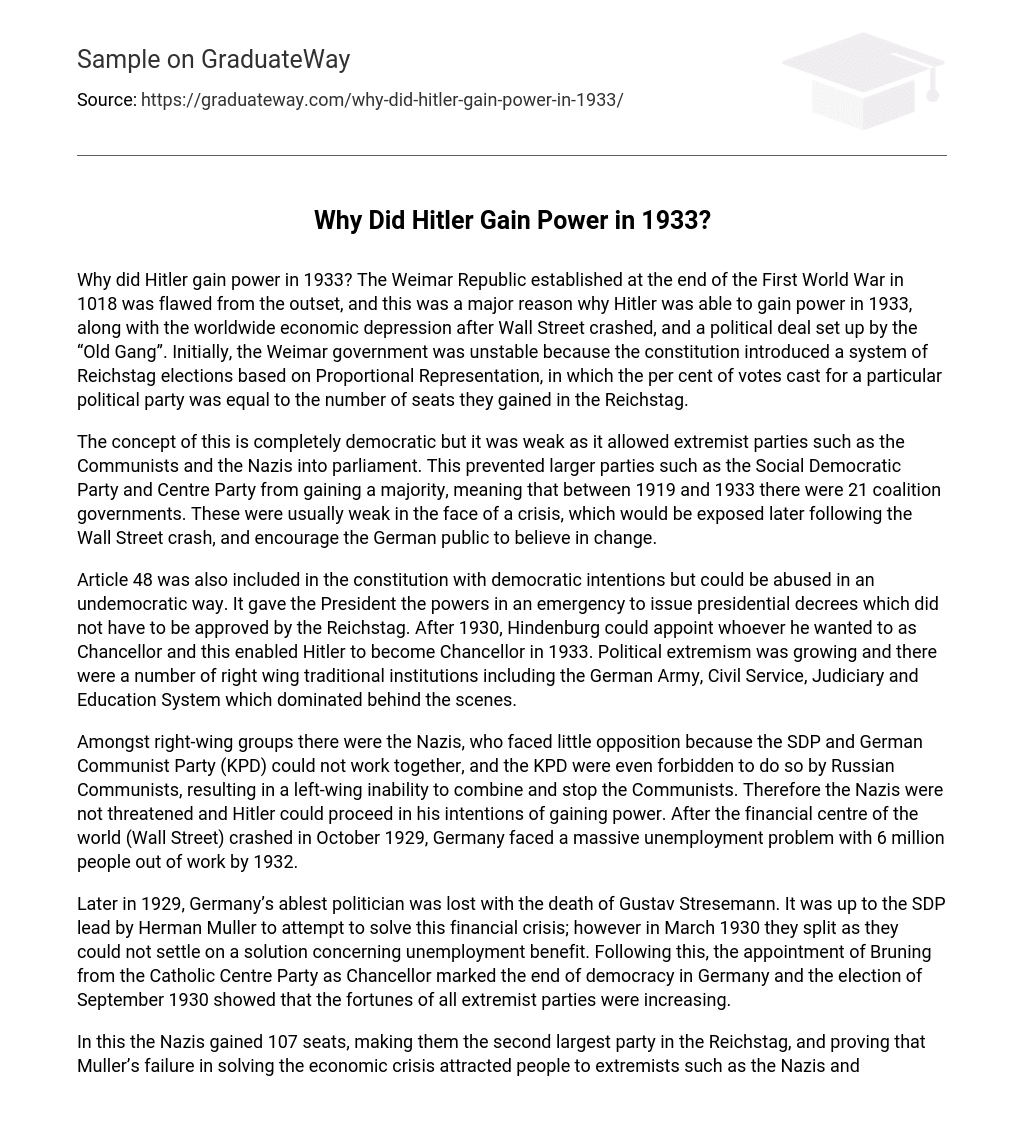Why did Hitler gain power in 1933? The Weimar Republic established at the end of the First World War in 1018 was flawed from the outset, and this was a major reason why Hitler was able to gain power in 1933, along with the worldwide economic depression after Wall Street crashed, and a political deal set up by the “Old Gang”. Initially, the Weimar government was unstable because the constitution introduced a system of Reichstag elections based on Proportional Representation, in which the per cent of votes cast for a particular political party was equal to the number of seats they gained in the Reichstag.
The concept of this is completely democratic but it was weak as it allowed extremist parties such as the Communists and the Nazis into parliament. This prevented larger parties such as the Social Democratic Party and Centre Party from gaining a majority, meaning that between 1919 and 1933 there were 21 coalition governments. These were usually weak in the face of a crisis, which would be exposed later following the Wall Street crash, and encourage the German public to believe in change.
Article 48 was also included in the constitution with democratic intentions but could be abused in an undemocratic way. It gave the President the powers in an emergency to issue presidential decrees which did not have to be approved by the Reichstag. After 1930, Hindenburg could appoint whoever he wanted to as Chancellor and this enabled Hitler to become Chancellor in 1933. Political extremism was growing and there were a number of right wing traditional institutions including the German Army, Civil Service, Judiciary and Education System which dominated behind the scenes.
Amongst right-wing groups there were the Nazis, who faced little opposition because the SDP and German Communist Party (KPD) could not work together, and the KPD were even forbidden to do so by Russian Communists, resulting in a left-wing inability to combine and stop the Communists. Therefore the Nazis were not threatened and Hitler could proceed in his intentions of gaining power. After the financial centre of the world (Wall Street) crashed in October 1929, Germany faced a massive unemployment problem with 6 million people out of work by 1932.
Later in 1929, Germany’s ablest politician was lost with the death of Gustav Stresemann. It was up to the SDP lead by Herman Muller to attempt to solve this financial crisis; however in March 1930 they split as they could not settle on a solution concerning unemployment benefit. Following this, the appointment of Bruning from the Catholic Centre Party as Chancellor marked the end of democracy in Germany and the election of September 1930 showed that the fortunes of all extremist parties were increasing.
In this the Nazis gained 107 seats, making them the second largest party in the Reichstag, and proving that Muller’s failure in solving the economic crisis attracted people to extremists such as the Nazis and the Communists who gained a significant 77 seats. In the next year, the Nazi party began to grow and Hindenburg relied more and more on a military clique for advice, led by Von Schleicher, who later took more responsibility and instructed Hindenburg to sack Bruning, becoming Defence Minister himself.
Giving Schleicher this power meant that he was able to lift the ban on Hitler’s SA, with the hope that they would abolish the Communists. This was a crucial decision for Hitler because although the Nazis were unable to rid Germany of the Communists, the SA could potentially to some extent intimidate people into voting for the Nazis in 1933, and an increase in Nazi violence meant an increase in Nazi visibility. The election of July 1932 was proof that this resulted also in an increase in Nazi popularity, as they gained 236 seats, and were still the biggest party in November that year.
That December, Schleicher made himself Chancellor by dismissing Von Papen, with the aim of splitting the Nazi party by appealing to a socialist element. Following the failure of this plan, Schleicher retired and two days later Hitler was appointed Chancellor under Article 48 without an election. Although he was now in power, Hitler was largely restricted as Von Papen took up the new role of Vice Chancellor to monitor him, and there were only two other Nazis in his cabinet.
In conclusion, this raises the question that perhaps Hitler was hired by the “Old Gang” as part of a deal to rid Germany of the Communists before they would then deliberately sack him, as there was no impressive act in which he swept power. Anyhow, it is still evident from the elections of 1932 that the economic crisis and the Weimar Government’s weak response were both reasons why people in Germany sought help from extremists, increasing Nazi popularity and allowing Hitler to come to power in 1933.





